Turning Passengers into Pilots: Lessons from 60 Years of Workplace Data
Drivers, Riders, and Saboteurs: 60 Years of Workplace Dynamics in the U.S. and Europe
Every office is really three offices at once. In the first, a minority of people push initiatives forward, spot problems before they metastasize, and generally keep the lights on. In the second, a comfortable majority glide along—competent enough, but emotionally checked out. In the third, a truculent few undermine, obstruct, and occasionally light metaphorical fires just to watch them burn. Call them Drivers, Riders, and Saboteurs.
That taxonomy has been hiding in plain sight for decades, but only in the last generation have we started counting how many occupants sit in each room. And when you plot the numbers across sixty years, two rich regions, and two very different employment regimes—private enterprise on one hand, mission-driven bureaucracy on the other—an unmistakable pattern emerges: the ratios barely budge. Culture wars, macro cycles, technological revolutions—none of it moves the needle by more than a few percentage points. Why?
The Long Arc: 1960 → 2020
The command-and-control era. In the post-War decades, U.S. managers embraced “Theory X”: workers are naturally lazy; diligence must be coerced. Europe added an extra layer of paternalism and ironclad job security. Predictably, the system produced a large, complacent middle and a small cadre of rebels. When dismissal is improbable and careers are defined by seniority, the rational employee invests just enough effort to avoid trouble.
The differentiation backlash. By the 1980s, globalization turned the spotlight on productivity. Jack Welch institutionalized forced ranking and the annual purge at GE, and many U.S. firms copied him. Meanwhile, privatization crept through Europe, but labor protections never truly loosened. The result? In America, Saboteurs felt a sharper sword; in Europe, they often remained ensconced. Riders, however, proved resilient—coasting is a hard habit to break when the median performer is still useful.
The engagement turn. Around 2000, consultants distilled hundreds of organizational psychology papers into one metric—employee engagement—and discovered what any bartender could have told them: about a quarter of workers are fired up, the rest are phoning it in. Private companies spent the next two decades nudging that number into the low thirties; many European workplaces hovered near the teens. Public institutions lagged in both regions, hamstrung by rigid pay scales and byzantine procedures for removing dead weight.
The pandemic blip. 2020 gave us a bizarre engagement spike—shared crisis tends to focus the mind—but by 2022 burnout and “quiet quitting” restored the old equilibrium. The deeper truth: macro shocks shuffle seating assignments, but they rarely change the size of the rooms.
What Really Drives the Split?
Management quality. Seventy percent of team morale is traceable to who signs the performance reviews. A competent leader sets clear goals, offers feedback, and—crucially—acts on it. A mediocre one confuses motion with progress, thereby manufacturing Riders and energizing Saboteurs.
Accountability architecture. Silicon Valley’s “up-or-out” ethos and Westminster’s civil-service tenure sit at opposite ends of a continuum. Where low performance is expensive, Saboteurs either reform or exit. Where it is merely awkward, they linger and demoralize the rest.
Purpose alignment. People are willing to grind when they believe the grind matters. A for-profit can pay that belief in equity; a government agency must pay it in narrative. Either way, the story has to be told—often.
Growth pathways. Skill atrophy converts Drivers into Riders. Rotations, stretch projects, and continuing education keep talent from rusting. When opportunities vanish, even the true believers disengage.
Cultural context. Yes, some European workers really do “work to live,” and some Americans live to work. But cross-country differences shrink inside organizations that nail the first four items. Culture amplifies incentives; it rarely overrides them.
Why the Ratios Matter
Aggregate them across an economy and the consequences get macro-sized. High-engagement firms post double-digit productivity premia and suffer dramatically less absenteeism and churn. Conversely, Saboteurs are a tax on everyone’s cognitive bandwidth, and Riders quietly erode quality and innovation. Gallup’s latest estimate—roughly nine percent of global GDP evaporates in disengagement—is eye-watering but intuitive once you consider how many projects stall while people wait for someone else to care.
Can We Resize the Rooms?
History suggests we can trim the Saboteur share and drag a slice of Riders into Driver territory, but wholesale transformation is fantasy. Still, three interventions have survived repeated trials:
Hire—and fire—managers on people metrics. Make engagement scores part of the bonus calculus. If a leader can’t rally a team, take away the team.
Tie recognition to observable impact. Drivers need spotlighting, Riders need a nudge, and Saboteurs need consequences. The specifics differ by sector, but the feedback-loop principle is universal.
Flatten the onboarding gradient. The first six months decide whether a newcomer joins the Drivers or Riders. Saturate that window with mentorship, training, and small wins.
None of this is rocket science, but it is persistence science. Engagement isn’t a sprint; it’s a hygiene regime—skip it for a quarter and the organizational cavity forms. Sixty years of data tell us the same story twice: the distribution of workplace energy is stubborn, and the easy fixes were applied long ago. Yet incremental gains compound. A single-digit bump in Driver density can, over time, yield outsize returns in innovation, customer loyalty, and yes, GDP.
The office will never be entirely free of Saboteurs, and there will always be Riders content to coast. But if leadership treats engagement like CapEx rather than window dressing, the back seat shrinks, the engine hums, and the road ahead gets a little straighter.


